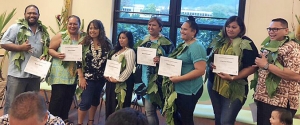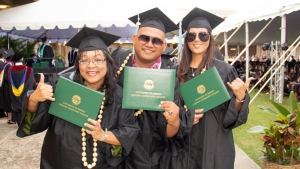In fall 2018, 37 dedicated educational assistants (EAs) living in Waiʻanae enrolled in a program to help them become certified teachers and earn a bachelor of science degree, while continuing to work full-time in local schools. Pursuing such a degree would normally entail tuition costs of around $36,720. But these EAs received scholarships and stipends that covered 100% of the tuition costs for a bachelor of science in special education.
That’s thanks to the Nānākuli Educational Assistant-to-Teacher Pilot Program, a project that aims to improve the recruitment, support and retention of educators from local communities. The program was specifically designed to alleviate the chronic shortage of special education teachers across Hawaiʻi by recruiting candidates with demonstrated experience and commitment to working with students with special needs and who are from the communities they serve. The Institute for Native Pacific Education and Culture (INPEACE) partnered with Leeward Community College to design the program.
Untapped gold mine

“We decided to get involved in this Nānākuli Education Assistant Project because of the teacher shortage, especially in [special education],” said Jeffrey Judd, teacher program coordinator at Leeward CC. “And we found this beautiful, untapped gold mine here in educational assistants in Nānākuli.”
The program provides comprehensive wrap-around services to support this non-traditional student population, which includes first-time college attendees and students with limited exposure to navigating online higher education. It is leading the charge in establishing a long-term pipeline of locally sourced, highly invested and culturally competent teacher candidates to work in Hawaiʻi public schools with chronic teacher turnover.
Judd said they are working to extend the program up and down the Leeward coast.
“If we’re able to do that, I think we’ll actually have an impact on how many teachers are actually being hired on the Leeward coast,” he said. “And we can break that horrible, horrible cycle of seeing people coming in and coming out all the time.”
Hard work pays off

It is not an easy process for the EAs, even with full free tuition. They still work 40 hours a week, while completing a 120-credit bachelor’s degree. The program also requires 450 hours of field experience in a classroom with students receiving special education services.
Naomi Nihipali, a community recruiter for Kūlia and Kalama Education Academy, said the EAs see how all the hard work pays off.
“I think it’s important for our keiki to see themselves in the classroom, to see their teacher as someone who lives in their community so that they can aspire to be teachers themselves,” Nihipali said. “It’s important that we look within our community because we have so many people who just need the right support in order to become teachers here.”
Diverse support
Tuition for the EAs comes from a combination of sources: a Health Resources and Services Administration grant, a James and Abigail Campbell Family Foundation grant, a Institute for Native Pacific Education and Culture grant and a University of Hawaiʻi–Hawaiʻi Department of Education special education grant.
“When we develop those avenues, especially when we’re working with INPEACE and everybody else, it gives us the best opportunity to recruit the very best that’s coming out of those communities,” Judd added. “And here in Nānākuli, there’s nobody better than the educational assistants, who work with those kids every day, to step up and be their teachers.”
Learn more about Leeward CC‘s teacher education program.
—By Tad Saiki

